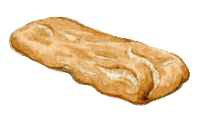Ciabatta

Form: Elongated white bread
Country of origin: Italy
What distinguishes it from other methods of bread making: Extremely dehydrated dough
Category of bread: (3) It rather resembles a rectangular French bâtard, a long stick of white bread, and fits into the category of risen breads with crust
Particularity: Adopted by all of Italy, using research by race car driver turned miller Arnaldo Cavallari
Ingredients: French grade T65 wheat flour ("tradition" without added ascorbic acid); baker’s yeast; olive oil; salt; water (highly hydrated batter)

Italy
Ciabatta saw the light of day in Veneto at the end of the 20th century. This is rather surprising, since most breads offered by Italian bakers seem to date back to Roman and even more ancient times. Most were already known by the Roman Empire, and we know that the bakers who presided over the capital of the Empire were for the most part Greek: proof that this country with a passion for bread is still today an innovator.
The distinctiveness of this long, rectangular bread – which is also served in smaller sizes, in the form of the popular panini – is that it derives from a particularly long fermentation. Ciabatta is made with flours with a high gluten content and a high water content, and offers a more or less open crumb and a more or less crunchy crust, depending on what it is to be used for.
The invention or rediscovery of this bread is thanks to Arnaldo Cavallari, who gave up his career as a race car driver to return to his family’s mills in Adria, south of Padua. He was passionate about the profession of bread baking, and tested different flours. He quickly developed recipes that focused on the quality of the wheat used. But what can be invented in a field where everything seems to have already been discovered? The answer is yes, it is possible. From the various experiments he carried out in his laboratories, the ciabatta was born, and in just a few years’ time, it was adopted by the illustrious family of Italian breads.

